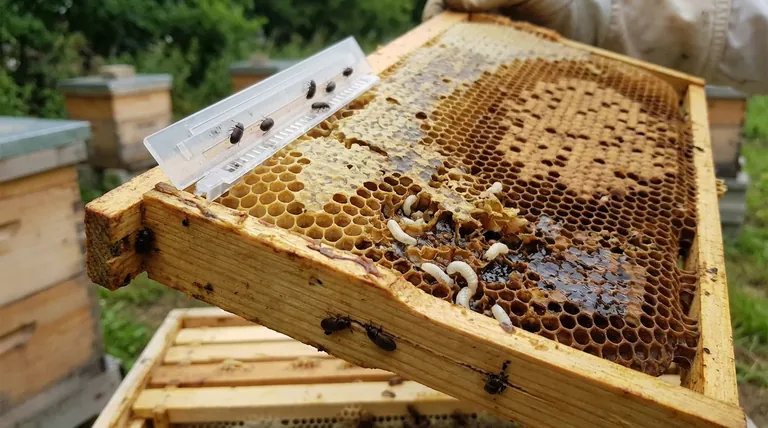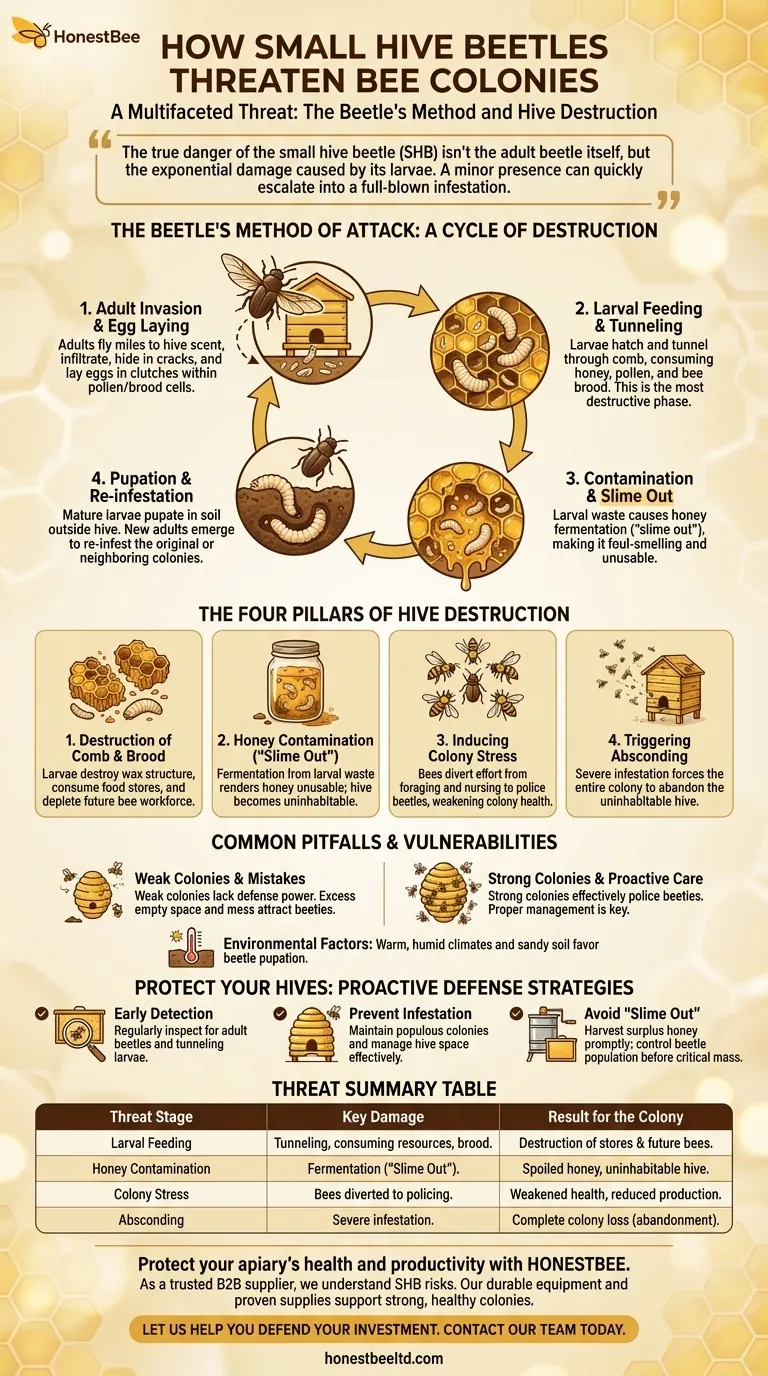Small hive beetles pose a multifaceted threat by attacking a honey bee colony's food supply, its young, and its overall structural integrity. The primary damage is not caused by the adult beetles, but by their voracious larvae, which tunnel through comb, consume resources, and contaminate the hive, potentially leading to a complete colony collapse.
The true danger of the small hive beetle (SHB) isn't the adult beetle itself, but the exponential damage caused by its larvae. A minor presence can quickly escalate into a full-blown infestation that consumes a colony's resources and forces the bees to abandon the hive.

The Beetle's Method of Attack
Understanding the SHB life cycle is key to recognizing the threat. The beetle employs a strategy that exploits the hive's own resources to reproduce and overwhelm it.
The Adult Beetle's Invasion
Adult beetles are adept at infiltrating hives. They can fly several miles to locate a colony, drawn by the hive's scent. Once inside, they often hide in cracks and crevices, avoiding the bees' defensive patrols.
Laying Eggs in a Secure Location
Female beetles lay their eggs in clutches within the hive. They prefer to use small cracks or deposit them directly into cells containing pollen or bee brood, providing an immediate food source for the hatching larvae.
The Larval Stage: The Real Destroyer
This is the most destructive phase. After hatching, the larvae begin to tunnel through the comb, consuming everything in their path: honey, pollen stores, and even bee eggs and larvae.
Pupation and Reinfection
Once mature, the larvae crawl out of the hive and burrow into the soil nearby to pupate. After a few weeks, a new generation of adult beetles emerges, ready to re-infest the original hive or neighboring colonies, creating a relentless cycle.
The Four Pillars of Hive Destruction
The damage caused by SHB is not a single event but a cascade of failures that undermine the colony's health and viability.
1. Destruction of Comb and Brood
Larvae burrowing through the honeycomb destroy the wax structure that bees use to store food and raise their young. By consuming bee eggs and larvae, they directly deplete the colony's future workforce.
2. Contamination of Honey ("Slime Out")
This is often the final blow. As the larvae feed, they defecate in the honey. Their waste contains a specific yeast that causes the honey to ferment, bubble, and run out of the cells. This foul-smelling, spoiled honey is called a "slime out," and it is completely unusable by the bees or the beekeeper.
3. Inducing Colony Stress
A healthy hive will dedicate a significant number of "guard" bees to corralling adult beetles into "prisons" made of propolis. This constant policing effort diverts workers from essential tasks like foraging, nursing brood, and producing honey, placing the entire colony under chronic stress.
4. Triggering Absconding
In a severe infestation, the combination of destroyed comb, spoiled honey, and the sheer mass of writhing larvae makes the hive uninhabitable. The honey bee colony will often choose to abandon the hive entirely, a phenomenon known as absconding.
Common Pitfalls and Vulnerabilities
Not all colonies are equally susceptible to SHB. The outcome of an encounter often depends on the colony's strength and the beekeeper's management practices.
The Weak Colony's Disadvantage
A strong, populous colony is the best defense. These hives have enough workers to effectively police adult beetles and remove larvae before an infestation takes hold. Weak or small colonies lack the bee power to mount an effective defense, making them prime targets.
The Beekeeper's Role
Certain beekeeping practices can inadvertently help the beetles. Giving a colony too much empty space (e.g., adding honey supers too early) provides beetles with undefended areas to hide and lay eggs. Leaving honey-processing messes near the apiary can also attract beetles from the surrounding area.
Environmental Factors
Small hive beetles thrive in warm, humid climates with sandy or loose soil, which is ideal for their pupation stage. Beekeepers in these regions face a much more persistent and significant threat than those in cooler, drier climates.
How to Apply This Knowledge to Protect Your Hives
Understanding the nature of the SHB threat allows you to shift from a reactive to a proactive defense strategy. Your actions should be tailored to interrupting the beetle's life cycle and bolstering your colony's natural defenses.
- If your primary focus is early detection: Regularly inspect for adult beetles in corners and on top bars, and immediately investigate any signs of the small, white larvae tunneling in the comb.
- If your primary focus is preventing infestation: Maintain strong, populous colonies as your first line of defense and avoid giving bees more space than they can effectively patrol.
- If your primary focus is avoiding a "slime out": Harvest surplus honey promptly and manage beetle populations before they can lay a critical mass of eggs, as a slime out is irreversible.
Understanding the beetle's strategy is the first and most critical step in defending your colonies effectively.
Summary Table:
| Threat Stage | Key Damage | Result for the Colony |
|---|---|---|
| Larval Feeding | Tunneling through comb; consuming honey, pollen, and brood. | Destruction of food stores and future bee population. |
| Honey Contamination | Defecation in honey causes fermentation ("slime out"). | Spoiled, unusable honey; hive becomes uninhabitable. |
| Colony Stress | Bees are diverted to policing beetles instead of foraging/nursing. | Weakened colony health and reduced honey production. |
| Absconding | Severe infestation makes the hive unsustainable. | Complete colony loss as bees abandon the hive. |
Protect your apiary's health and productivity with HONESTBEE.
As a trusted supplier for commercial apiaries and beekeeping equipment distributors, we understand that a small hive beetle infestation can lead to significant financial loss. Our wholesale-focused operations provide the durable equipment and proven supplies you need to maintain strong colonies and implement effective beetle management strategies.
Let us help you defend your investment. Contact our team today to discuss your specific needs and discover how our products support healthy, thriving hives.
Visual Guide

Related Products
- Removable Washable Hive Beetle Trap Attractants for Small Hive Beetles
- Black Plastic Beetle Barn Hive Beetle Trap for Beehives
- Reusable Clear Small Hive Beetle Traps for Beehives Beetle Trapping Tools
- Plastic Beetle Blaster Trap Beekeeping Tools and Supplies
- Professional Galvanized Hive Strap with Secure Locking Buckle for Beekeeping
People Also Ask
- What are the steps for installing hive beetle traps? A Guide to Effective Beetle Control
- What is the recommended number of beetle traps per hive? Optimize Your Hive's Beetle Defense
- How should filled beetle traps be handled? Safely Remove and Dispose to Protect Your Hive
- What should be done if a hive shows signs of a small hive beetle infestation? Protect Your Hive Now
- What are small hive beetles and where are they not indigenous? Protect Your Apiary from This Invasive Pest



















